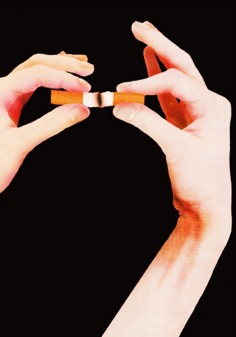Agnieszka Polska
The Kiss

source: nottinghamcontemporaryorg
Agnieska Polska’s dreamlike videos explore time and memory. Born in Poland, in 1985, while it was still a communist state, she is interested in forgotten histories and cultural myths, particularly those of vanished artists.
Her video Future Days shows the imagined afterlife of a group of artists who have disappeared from art history. It includes Lee Lozano whose conceptual work Decide to Boycott Women led to her complete withdrawal from the art world, and Bas Jan Ader, a legend of conceptual art, who was mysteriously lost at sea. Polska reunites them with artists from other eras in a beautiful summery afterlife, filmed on a Swedish island.
Polska’s work is influenced by her research in historical archives. She sees an archive as a living organism that is “alive and subject to incessant change.” This means that history itself is constantly misremembered. It is imperfectly recorded, or reinterpreted after political change. There are psychological reasons for forgetting too, as analysed by Sigmund Freud. Her hallucinatory videos fill in the gaps, accidental or deliberate, in Eastern European art history.
The pace and hypnotic quality of her work is sometimes similar to ASMR, (Autonomous Sensory Meridien Response) videos – a cult internet phenomenon. Polska invites viewers to have a similarly meditative, immersive
response to her work. Influenced by the theatrical production Not I by the playwright Samuel Beckett, her video I am the Mouth II shows an animated red mouth, half-submerged in turbulent water. Based on a scientific
description of sound waves moving through different materials, the mouth “speaks” for the art work.
.
.
.
.
.
.
.
source: culturepl
Agnieszka Polska creates video works employing mainly found material, such as archive photography and illustrations, which she subjects to subtle interventions, whether animating them or working them into the existing image. In the process, the artist changes their primary context, simultaneously creating illusions of documentation. She investigates the impact of documentation on its future reception. Her visually powerful explorations of lost times or half-forgotten figures of the Polish avant-garde, turn to how the past is fictionalised and re-worked. Her animated videos evoke a sense of melancholia, and a longing for something that perhaps never was, but which she makes real at least on film. In an interview with Art Review, Polska said that, “Slow, unnaturally calm movements are present in most of my videos. I mainly work with animated film so a meditative, contemplative quality is present also in the process of production, which is very important for me. Each project needs a lot of time and concentration (for viewer and maker)”.
As Polska says,
Misunderstandings or erroneous interpretations are all factors, which push art forward creating new values and posing new questions. An archive – as every living organism – is alive and subject to incessant change, forever multiplying images of itself. The elements negated and rejected during the process of archivisation, later appear as the dark matter of our subconsciousness.
.
.
.
.
.
.
.
source: nottinghamcontemporaryorg
Polish artist Agnieszka Polska is interested in the processes by which things come to be forgotten, whether through lack of archiving or deliberate political amnesia – particularly in the post-War era when communist societies became capitalist. Her beautifully crafted animated videos revisit forgotten events in art or history. She also examines how things are recreated in the present through myth, memory and imagination.
.
.
.
.
.
.
.
source: artdiscover
Vive y trabaja en Cracovia y Berlín
1985: Nació en Lublin, Polonia
Agnieszka Polska crea obras de vídeo empleando el material que se encuentra principalmente, como archivo de la fotografía y las ilustraciones, sujetos a intervenciones sutiles, ya sea animación o les de trabajo en la imagen existente. En el proceso, el artista cambia su contexto primario, creando al mismo tiempo las ilusiones de la documentación. Ella investiga el impacto de la documentación sobre su recepción futuro. Sus visualmente poderosas exploraciones de tiempos perdidos o figuras casi olvidados de la vanguardia polaca, recurren a cómo el pasado es ficticia y reelaboradas. Sus videos animados evocan un sentimiento de melancolía y la nostalgia de algo que tal vez nunca lo fue, pero que se hace real, al menos en la película.
En una entrevista con Art Review, Polska dijo que, “Los movimientos lentos, extrañamente tranquilas están presentes en la mayor parte de mis videos. Yo trabajo principalmente con la película de animación para una meditación, la calidad contemplativa está presente también en el proceso de producción, que es muy importante para mí. Cada proyecto necesita una gran cantidad de tiempo y concentración (por espectador y creador)”.
.
.
.
.
.
.
.
source: goethede
Agnieszka Polska wurde 1985 in Lublin geboren, lebt und arbeitet in Berlin und Krakau. Sie hat einen Abschluss an der Kunsthochschule in Krakau und an der Universität der Künste in Berlin. Agnieszka Polska begann 2007 in Krakau, ihre Werke auszustellen. Seitdem hat sie an Gruppenausstellungen am KW Institute for Contemporary Art in Berlin 2010 und 2011 sowie am Tate Modern in London 2012 teilgenommen.
Agnieszka Polska bedient sich in ihren Videowerken vor allem fertiger Materialien wie Archivbildern und Illustrationen, die subtilen Interventionen ausgesetzt werden, indem sie diese entweder animiert oder in existierende Bilder einbettet. Während des Prozesses moduliert die Künstlerin deren Kontext und schafft gleichzeitig die Illusion, das Bild sei dokumentarisch. Sie untersucht, wie das Dokumentarische die Wahrnehmung des Bildes prägt. Ihre visuell kraftvollen Untersuchungen vergangener Zeiten oder vergessener Persönlichkeiten der polnischen Kunstavantgarde erforschen, wie die Vergangenheit fiktionalisiert und bearbeitet wird.

